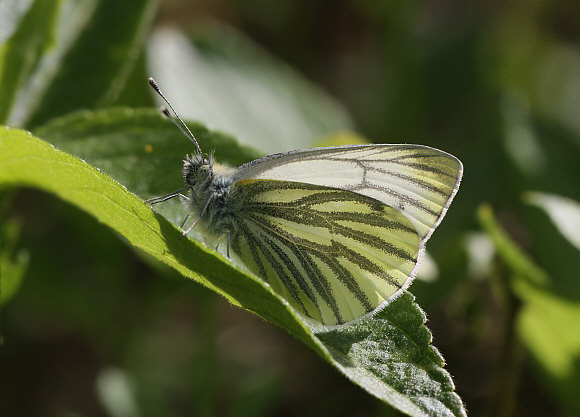 Green-veined White Pieris napi, 1st brood male, Stansted Forest, Sussex – Adrian Hoskins
Green-veined White Pieris napi, 1st brood male, Stansted Forest, Sussex – Adrian Hoskins
Introduction
This is a widespread and common species occurring throughout Europe, temperate Asia, and at high altitudes in the Atlas mountains of north Africa. It also occurs in North America where it is known as the Mustard White.
When seen in flight it can be confused with the Small White Pieris rapae. The latter however has a strong directional flight pattern, unlike the delicate fluttering of the Green-veined White. It can also be confused in flight with the female Orange tip Anthocharis cardamines, which flies in very similar habitats. The differences between the two are apparent once the butterfly has settled – the Orange tip has a very distinctive mottled green and white underside quite unlike that of napi.
The two broods of the Green-veined White differ slightly in appearance. The underside hindwings of the spring brood are pale yellowish with the edges of the veins heavily peppered with grey. Those of the summer brood adults are richer in colour and have the peppering much reduced. On the upper surface females of both broods have a pair of suffused blackish spots on each forewing. First brood males lack these spots entirely, but there is a single spot present on males of the summer brood.
I have sometimes come across individuals that were very much smaller than average, for example at Noar Hill, Hampshire, in August 2004, and again at Stockbridge Down on 14th July 2007 I found singletons each no larger than a Chalkhill Blue.
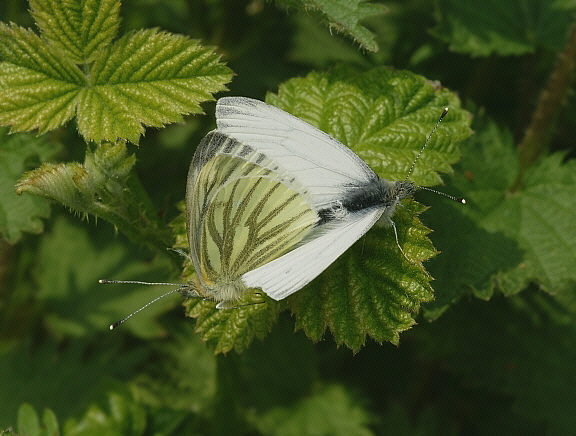 Green-veined White Pieris napi, 1st brood pair, Hampshire – Adrian Hoskins
Green-veined White Pieris napi, 1st brood pair, Hampshire – Adrian Hoskins
Habitats
The Green-veined White is found throughout Britain, with the exception of the Shetland Isles. It is found in damp sunny sheltered situations such as woodland rides and glades, along riverbanks and in wet meadows. Although it can sometimes be seen flying in open habitats such as grassland and heaths, it usually prefers to stay close to its breeding sites.
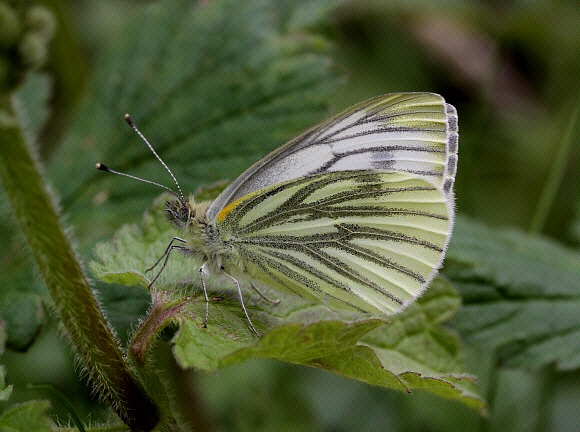 Green-veined White Pieris napi, 1st brood female, Stansted Forest, West Sussex – Adrian Hoskins
Green-veined White Pieris napi, 1st brood female, Stansted Forest, West Sussex – Adrian Hoskins
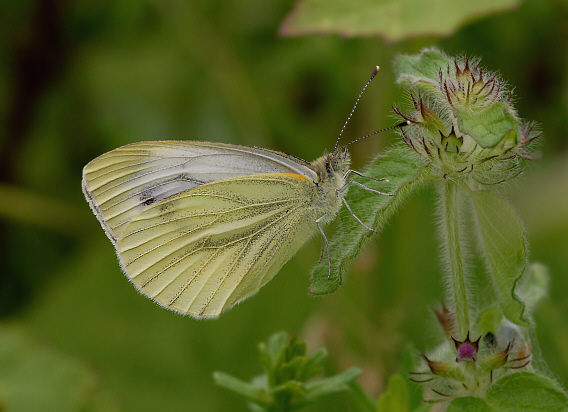 Pieris napi, 2nd brood female, Stockbridge Down, Hampshire – Adrian Hoskins
Pieris napi, 2nd brood female, Stockbridge Down, Hampshire – Adrian Hoskins
Lifecycle
There are usually 2 generations in the UK, emerging in May-June and again in early August. The 2nd brood is always more numerous than the first. In warm years there may also be a partial 3rd brood which emerges in late September. At high altitudes and in Scotland however there may be just one brood, emerging in June.
The straw-coloured eggs are laid singly on the undersides of leaves of various crucifers, including cuckoo flower Cardamine pratensis, garlic mustard Alliaria petiolata, hedge mustard Sisymbrium officinale and water cress Nasturtium officinale; more often on tiny seedlings than on larger plants. The butterflies usually prefer to oviposit on plants growing in damp sunlit situations, often along the edges of woodland ditches and paths. The caterpillar feeds solitarily during daylight, and is a dark slightly bluish green colour, with yellow spiracles. It can be found in June and again in August.
The offspring of spring adults usually produce pale green pupae, which blend perfectly amongst living stems and leaves. Those produced by the offspring of summer adults however are destined to spend the winter in hibernation, attached to dry woody stems, and are usually pale straw in colour.
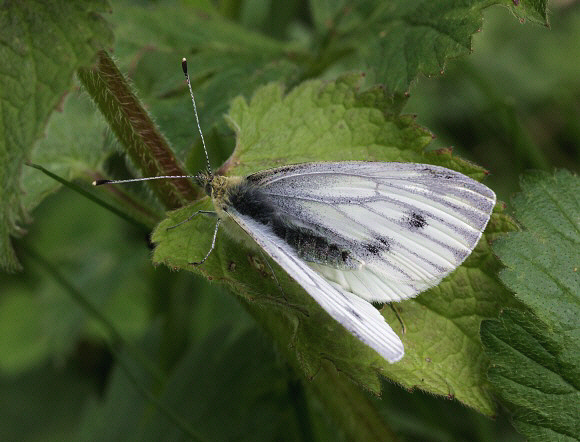 Green-veined White Pieris napi, 1st brood female, Stansted Forest, West Sussex – Adrian Hoskins
Green-veined White Pieris napi, 1st brood female, Stansted Forest, West Sussex – Adrian Hoskins
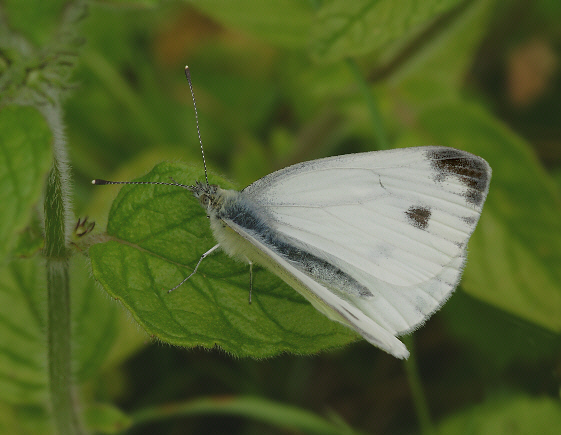 Green-veined White Pieris napi, 2nd brood male, Hampshire – Adrian Hoskins
Green-veined White Pieris napi, 2nd brood male, Hampshire – Adrian Hoskins
Adult behaviour
Green-veined Whites, in common with their close relatives the Small and Large Whites, are among the first butterflies to take flight on cool or overcast days, often appearing an hour or more before other species awaken. In such weather conditions they spend long periods reflectance-basking, but take flight as soon as the clouds thin and there is a hint of warmth.
| Reflectance basking : In cool or hazy conditions Green-veined Whites normally bask with their wings held slightly apart. This causes solar radiation to be reflected onto the dark thorax, thereby enabling them to gain energy rapidly. This habit is also practiced by Small Whites, Large Whites, Orange tips, Small Coppers and most Blues. |
In sunny weather the butterflies make short but regular flights, pausing here and there to nectar at low growing flowers. Spring nectar sources include bugle, dandelion, cuckoo flower and cranesbill, while the summer generation favours knapweed, marjoram, thistles and hemp agrimony. Males also commonly imbibe mineralised moisture from the edges of puddles.
Freshly emerged females sit among grasses or low herbage to await discovery by patrolling males. Mating takes place after a short chase, and immediately after copulating the pair fly to settle on a bush or on higher ground, with the male carrying the female in flight. If disturbed the copulated pair take readily to the wing and often make several short flights until they find a spot where they are out of reach of predators. They remain paired for about an hour.
At Stansted Forest in May 2008, I watched a Green-veined White searching for places to lay her eggs. Every few seconds she alighted momentarily on a leaf, ‘tasting’ it using the olfactory sensors on her feet to check whether or not it was the correct foodplant for her offspring. It was surprising to find that she tested bracken, ivy and oak leaves, all of which are very different in shape from the crucifers she needed to locate for oviposition. This appears to indicate that visual stimuli play little or no role in selecting plants for egg-laying with this species.
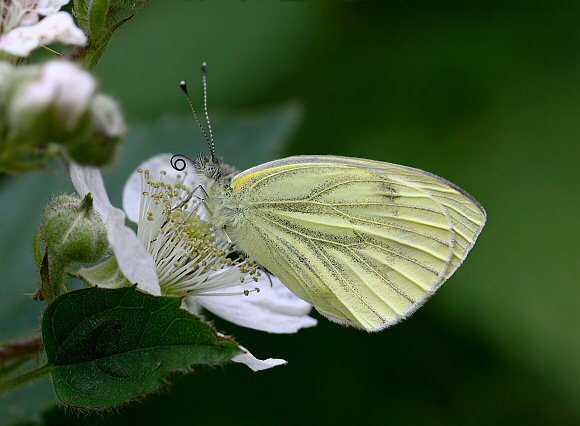
Green-veined White Pieris napi, 2nd brood female, Bedwyn Brail, Wiltshire – Adrian Hoskins
